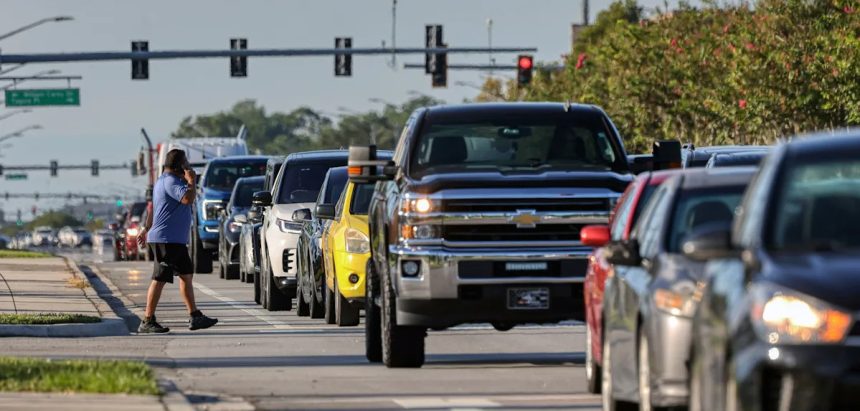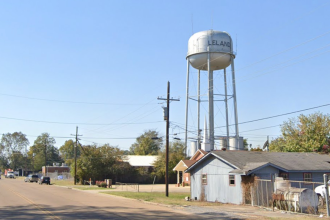There’s a new grocery store near his home in St. Cloud, but Bob Turner never shops there, driving to a store farther away for one reason: To avoid the most traffic-clogged stretch of Narcoossee Road.
“It’s crazy,” Turner said. “They just built a new Publix close to my home, but I never go because you have to turn left and with the traffic, good luck.”
Turner lives in a neighborhood where the only entry and exit are onto Narcoosee, one of the region’s most congested roads. Turning left, and heading south, puts him in the worst of it, though traffic up and down the roadway often is a challenge.
The six-lane road traverses roughly 17 miles, crossing the Orange and Osceola county line and serving as the main thoroughfare for Lake Nona, one of the region’s fastest growing communities. Its condition is a dilemma with no clear solution, at least in the short term, a monument to some of the worst aspects of Central Florida’s land-use and transportation planning and a lesson in what not to do elsewhere.
Since 2015, the daily vehicle count for the stretch of road in the city of Orlando has increased by over 30%, data from the city shows.
The count for the Orange County section, between the Beachline and the Osceola border, has jumped from 38,000 vehicles per day in 2022 to 58,500 in 2024, data from the Florida Department of Transportation shows. That puts it over the recommended capacity of 55,000 daily vehicles for a six-lane road, according to the Highway Capacity Manual, the standard reference for analyzing traffic operations nationwide.
The section in Osceola has leapt from 29,500 daily vehicles to 41,500 vehicles for the same time period. Data from Osceola County shows the heaviest traffic on its section is on the lanes heading south to St. Cloud, another booming region in Central Florida.
“The entire area has seen explosive growth in recent years,” said Mary Ann Horne, spokeswoman with MetroPlan Orlando, the region’s road planning agency, in an email.
Among Central Florida roads that are not highways, only U.S. 192, Colonial Drive and John Young Parkway have higher average daily vehicle counts than Narcoossee Road, according to FDOT data.
Narcoossee’s congestion is fueled by residential and commercial building booms in both Lake Nona and St. Cloud, two communities striving for the economic rewards that come with growth. Three different local governments share responsibility for the road, and their fragmented efforts to manage traffic have frustrated some residents.
“The problem is there is no good city planning here between Osceola County and Orange County,” said Kristina Johnson, who moved to Lake Nona from Texas with her husband in 2021.
“It’s just gotten worse over the past four years that we’ve been here and just continues,” agreed Kyle Anderson, who moved from Ohio into Lake Nona’s Laureate Park neighborhood the same year. “It’s inevitable when you’re adding residential apartments and homes up and down Narcoossee and no road capacity. It’s gonna just keep getting tight.”
On a recent rush hour, the southbound lanes were bumper-to-bumper traffic.
In the Lake Nona area, the road is home to three schools, a Valencia College campus, numerous shopping plazas with retail giants like Publix, Sam’s Club and Walmart and fast food and chain restaurants. Within Orlando city limits there are 323 businesses along Narcoossee Road, city data shows, with about 20 new ones opening every year since 2020.
Lake Nona, a 11,000-acre planned community, includes dozens of neighborhoods, hundreds of commercial shops, office buildings for major companies like KPMG and a downtown that hosts an open-air container park and hotel. It’s home to the University of Central Florida’s college of medicine and hospital and Florida’s only U.S.Tennis Association campus.
Its A-rated public schools and easy access to Orlando International Airport add to the draw.
But most everything funnels to Narcoossee Road, which is also the key artery to get to State Road 417 and then access to the region’s other major thoroughfares.
Lake Nona developer Tavistock plans to build another community, Sunbridge, with up to 7,000 residential units, just a couple miles away. That could add more cars to the road. A spokesperson did not respond to questions about traffic on Narcoossee Road.
Jim Gray, an Orlando City Commissioner whose district encompasses Lake Nona, said the community’s growth has been a boon for the city.
“The negative to that is, you know, that brings traffic because it’s where people want to be,” Gray said. “I tell my neighbors, I’m stuck in traffic with you too.”
The city has worked to alleviate traffic but may not have many more options, Gray said.
Orlando widened its section of the road in 2023 from four to six lanes. But another expansion would be difficult as the road is surrounded by environmentally sensitive lands on one side and Lake Tohopekaliga on the other, Gray said.
Another challenge is that traffic signals are controlled by the three different local governments, and Gray said that can make it harder to time traffic lights to ease congestion.
Orange County manages signals between Irenic Way and Luminary Boulevard, Orlando controls the northern portion, and Osceola manages the southern tip.
The county has developed optimized signal timing plans with a goal of minimizing stops and delays, but the numerous schools, commercial and residential development mean lots of pedestrian traffic, “which can significantly disrupt traffic flow along this corridor,” said Darrell Moody, spokesperson for Orange County in an email.
Bad traffic on Narcoossee Road means more drivers now search for other options, sometimes cutting through neighborhoods.
“Getting through the neighborhood in the mornings can easily take 20 to 25 minutes just to go three miles,” said Johnson, who lives in Lake Nona’s Laureate Park neighborhood.
She is increasingly concerned as more drivers speed through Laureate Park, blowing by stop signs and failing to look out for pedestrians. She is lobbying for the city to consider adding double yellow lines on the street in front of her home, in an effort to keep drivers in their lanes and increase safety.
“Because there are so many cars coming and going, cars are now driving in the middle of the road,” Johnson said. “It’s almost like a game of chicken. I’m surprised there hasn’t been a head-on collision.”
Some reprieve could come from a controversial expressway project, though its opening is years away. The Central Florida Expressway Authority is planning to build State Road 534 from SR 417 near Boggy Creek Road in Orange County to Nova Road in Osceola County.
The toll road has been in the works for nearly 20 years as a solution to the area’s anticipated growth and could relieve some Narcoossee Road congestion. It will run through a portion of protected land on Split Oak Preserve, a move that has sparked outrage amongst conservationists and some residents.
“A lot of neighbors came out and said look we don’t want that… and so the project got put on hold,” Gray said. “I understand that, but the problem is growth kept going because everybody wanted to be in Lake Nona and Osceola County.”
The project now has gotten the go ahead, but construction will take years with an estimated completion date of 2032.
Turner moved into Lake Ajay Village in 2011. At the time, Narcoossee was a two-lane road and driving to SR 417 took him roughly ten minutes. Now that same route takes Turner, who frequently volunteers at the Orlando Philharmonic Orchestra in downtown Orlando, more than 30 minutes.
He and his wife are both retired and now try to time any trips away from home around the “terrible” traffic, especially at rush hour.
“We try not to leave home before 9 a.m. and come back home always before 3 p.m.,” he said.









